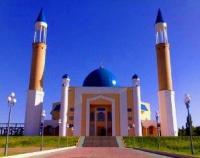Вы здесь
Central mosque of Taraz.

Excursion trip in Taraz.
“In order for the people to turn to national sources and restore their former spirituality and faith, I returned to the Muslim countries hundreds of mosques closed under Soviet power.”
Nursultan Nazarbaev. President of the Republic of Kazakhstan.
Tour of the mosques of Taraz.
At the mausoleum of Karakhan and Dautbek there is a wooden pointer that reminds of a mosque that stood there in the IXth - XIIth centuries. In the center of the Taraz bazaar, a huge mosque with a large blue dome was painted a thousand or more years ago.
The ruins of God's houses - Syzdyk Khoja for Togyzkent, Kara Khoja - in the area of Bestam, the nine-domed Ablishan mosque in Usharal, have survived to this day. By 1920, there were at least thirty Muslim religious institutions in the city of Taraz.
Previously, they represented a whole complex of buildings, because there, in addition to the prayer halls, there were madrassas, a library, a bathhouse and other services. The current Auliye-Ata mosque near the central market was built in 1902 - 1906.
The complex consisted of prayer rooms, a library, a bathhouse, a madrasah, an imam’s office. In the Soviet era, it was closed several times, reopened, then banned again. After a period of mass famine, a granary was located in the Aulie-Ata mosque, then it was turned into a barracks for the Red Army soldiers.
In 1943, the mosque again began to function for its intended purpose. Imams, Khoji, Mullahs, along with political and public figures, were repressed. Among those who served in the Auliye-Ata mosque, Taraz residents remember Imam J. Kozhash. Literate, religious figures were the imams of Kural, Zhumabay, Mullah Alim and a Dunganin named Mysyr, who for 16 years headed the mosque.
The following fact testifies to patriotism and spirituality of parishioners of the Auliye-Ata mosque and the Muslim community of Taraz: during the war they raised money to buy a tank for the Soviet Army. In those days, the Auliye-Ata mosque was decorated with national patterns, in the brickwork and architectural design, sharpness, experience, imagination and skill of builders were fixed.
The mosque went through several overhauls and each time lost the original features of the old building. In 1998, when I arrived there naib imam, another major overhaul was made, an extension was made, and the courtyard at the mosque was expanded.
Such a large amount of construction and repair work became possible only thanks to the support and help of the then leadership of the region. But the mosque, as I said, was gradually losing its beauty. This is evident by the difference in the southeast and west gates.
The old gates made of white bricks are still attractive. We’ll soon celebrate the centennial of the Karahodzhin’s sword in the village of Bestam. Time has shown that Taraz needs a large mosque of modern construction.
On July 6, 2003, builders scored the first peg of a new cult institution. It was built on people's money, voluntary donations from labor collectives, private individuals. And on April 27, 2007, on Friday, the day of general prayer, its grand opening took place.
The President of the country N. A. Nazarbayev and the chief mufti Absattar kazy Derbisaly took part in the celebrations. In the Auliye-Ata mosque, one and a half thousand people can pray at the same time. The same number of people serves a new mosque. However, on Friday prayers, as always, parishioners are crowded.
Now the central mosque will be named after Hibattula Ahmetula Tarazi. You all know the biography and exploits of the Kazakh sultan Beibarys, who led Egypt for 17 years. He built a huge madrasah there, and a native of Taraz invited him to head it. Hibattula Tarazi lived between 1272 - 1323 years.
He studied at one of the madrasas of Taraz. In the early 1300s, he embarked on a journey with his son. First, they arrived in Shamgu (Syria), then they moved to Mysyr (Egypt). The capital of Egypt remained forever. Hibattula gave lessons at the Sultan al-Zahir Beibarys madrasah, then became his head.
He was distinguished by honesty, erudition, and was considered a major specialist in fakih usuli - Muslim law and a brilliant translator. X. Tarazi followed in Islam the direction of Abu Hanifa. He wrote comments on the works of prominent Central Asian figures of Islam Abu Abdullah bin al-Shaibani (749 - 805), Ahmad bin Muhammad at-Tahui (853 - 933), Abd al-Karim bin Mussa al Bazdaui (XI - XII century. ), al-Nasafi and others. Buried in Cairo.
In Turkey, a solid scientific work has been discovered about this native of Taraz. X. Tarazi lived a righteous and just life and sincerely served Islam, without questioning the reality of both earthly and otherworldly life. He was always distinguished by godly fear and honesty, strictly adhering to his behavior within the framework of the requirements of Sharia.
Today in Taraz there are mosques of Abdykadyr, Asymat, Zuninat, Kublai Baba, Hamrakul, Nygmetbay and others - there are ten religious institutions in total.
Authority:
The “Banner of Labor" 2008, March 26. S. 3. According to the chief imam of the central mosque of Yerbol Sagiula Kosbagar. The author is Kuanyshbay Esirkegenov.







